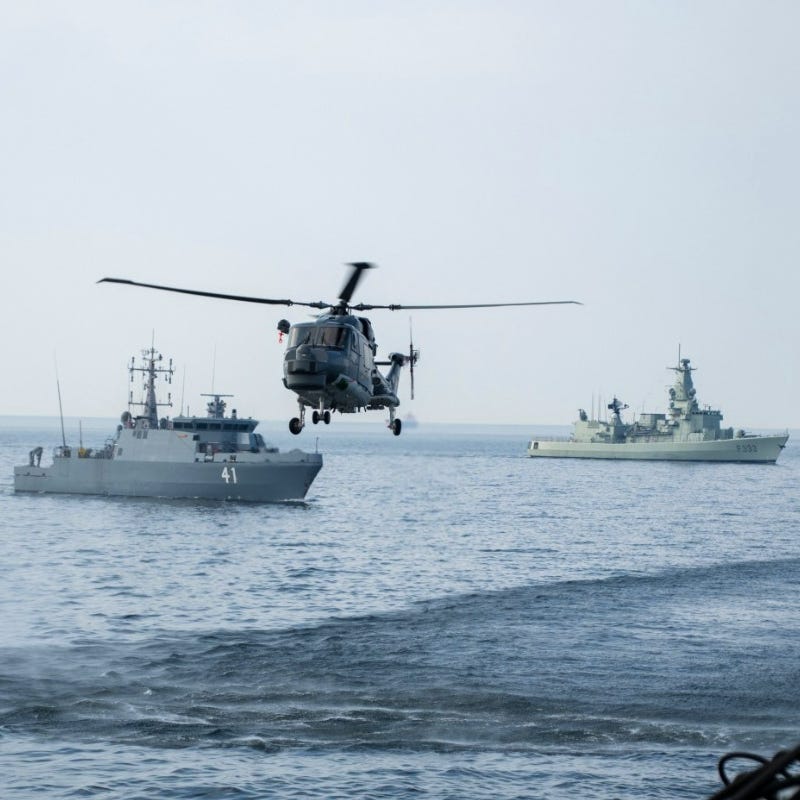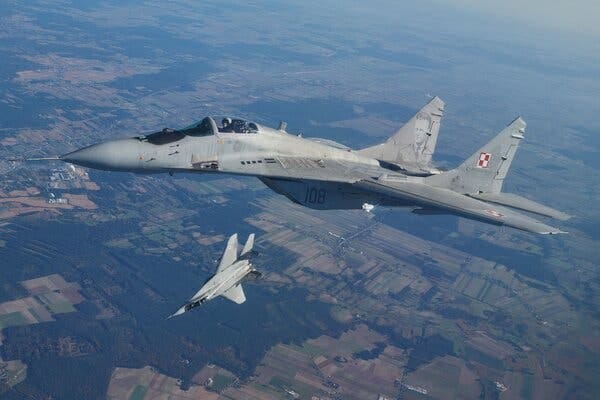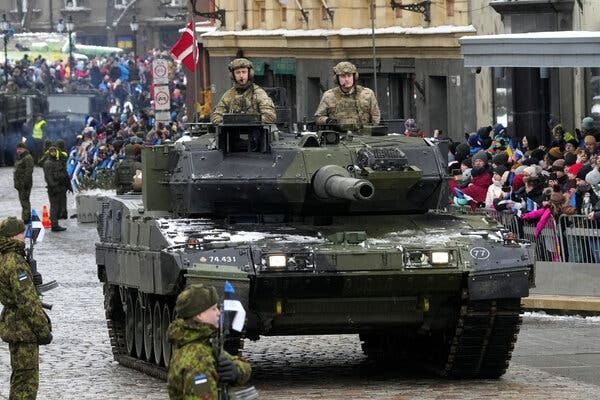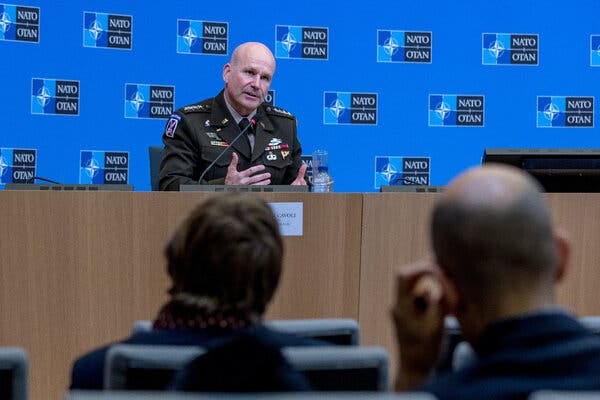Apr 25: Steven Erlanger, Russian Invasion of Ukraine Revolutionizes NATO Military Strategy
As published in The New York Times on April 17, 2023
Russian Invasion of Ukraine Revolutionizes NATO Military Strategy
By Steven Erlanger, The New York Times, April 17, 2023
Shocked by Russian atrocities, NATO is becoming the war-fighting alliance it was during the Cold War, committed to defending “every inch” of its territory from Day 1.
Russia’s invasion of Ukraine, the costliest conflict in Europe since World War II, has propelled the North Atlantic Treaty Organization into a full-throttled effort to make itself again into the capable, war-fighting alliance it had been during the Cold War.
The shift is transformative for an alliance characterized for decades by hibernation and self-doubt. After the recent embrace of long-neutral Finland by the alliance, it also amounts to another significant unintended consequence for Russia’s president, Vladimir V. Putin, of his war.
NATO is rapidly moving from what the military calls deterrence by retaliation to deterrence by denial. In the past, the theory was that if the Russians invaded, member states would try to hold on until allied forces, mainly American and based at home, could come to their aid and retaliate against the Russians to try to push them back.
But after the Russian atrocities in areas it occupied in Ukraine, from Bucha and Irpin to Mariupol and Kherson, frontier states like Poland and the Baltic countries no longer want to risk any period of Russian occupation. They note that in the first days of the Ukrainian invasion, Russian troops took land larger than some Baltic nations.
To prevent that, to deter by denial, means a revolution in practical terms: more troops based permanently along the Russian border, more integration of American and allied war plans, more military spending and more detailed requirements for allies to have specific kinds of forces and equipment to fight, if necessary, in pre-assigned places.
Mr. Putin has long complained about NATO encirclement and encroachment. But his invasion of Ukraine provoked the alliance to shed remaining inhibitions about increased numbers of Western troops all along NATO’s border with Russia.
The intention is to make NATO’s forces not only more robust and more capable but also more visible to Russia, a key element of deterrence.
“The debate is no longer about how much is too much,” for fear of upsetting Moscow, “but how much is enough,” said Camille Grand, until recently NATO’s assistant secretary general for defense investment, and now with the European Council on Foreign Relations.
The countries of Central and Eastern Europe insist that it is “no longer enough to say we’re ready to deter by promising to reconquer, but that we need to defend every inch of NATO territory from day one,” said Mr. Grand. “It’s not okay to be under Russian control for a few months until the cavalry arrives.”
NATO now has deployed a battalion of multinational troops to eight countries along the eastern border with Russia. It is detailing how to enlarge those forces to brigade strength in those frontline states to enhance deterrence and be able to push back invading forces from the start. And it is also tasking thousands more forces, in case of war, to move quickly in support, with newly detailed plans for mobility and logistics and stiffer requirements for readiness.
“NATO is an organization that took a holiday from history,” said Ivo H. Daalder, a former American ambassador to NATO. Mr. Putin, he said, “reminded us that we have to think about defense and think about it collectively.”
The alliance will put more troops under the direct control of NATO’s top military officer, the supreme allied commander Europe, Gen. Christopher G. Cavoli, who also commands American forces in Europe.
Under a new rubric of “deter and defend,” General Cavoli is for the first time since the Cold War integrating American and allied war-fighting plans, a senior NATO official said, speaking anonymously because of the topic’s sensitivity. Americans are back at the heart of Europe’s defense, he said, deciding with NATO precisely how America will defend Europe.
For the first time since the Cold War, the official said, East European countries will know exactly what NATO intends to do to defend them — what each country should be able to do for itself and how other countries will be tasked to help. And Western countries in the alliance will know where their forces need to go, with what and how to get there.
NATO is also aligning its longer-term demands from allies with its current operational needs. If in the past NATO countries might be asked to send some lightly armed expeditionary forces with helicopters to Afghanistan, for instance, now they will be tasked to defend particular parts of NATO territory itself.
For Britain, just one example, that will mean that it provide more heavy armor to defend NATO’s eastern flank, even if the British government would prefer to continue to field a lighter, more expeditionary army, requiring less money, fewer people and less expensive heavy equipment.
The planning in NATO is already intrusive but will become more demanding and specific. Countries answer questionnaires about their capacities and equipment; NATO planners tell them what’s missing or could be cut or thinned.
In one case, said Robert G. Bell, defense adviser to the American mission at NATO until 2017, Denmark was told to stop wasting money building submarines. Canada was told it must provide air-refueling planes.
Countries can push back — for years some nations with frigates refused to put air-defense missiles on them for fear of seeming escalatory — but they must defend their plans before all NATO members. If the other allies all agree that a country’s plan is inadequate, they can vote to force adaptation in what is known as “consensus minus one.” Such a demand is rare, but happened with Canada, Mr. Bell said.
Now the demands will be tougher and more rigorous to bring the alliance back to a war-fighting capacity in Europe and make deterrence credible — to ensure that NATO can fight a high-intensity war against a rival, Russia, from the first day of conflict.
The change at NATO began slowly in 2014 after Russia annexed Crimea, igniting insurrection in the eastern Donbas. At their summit that year in Wales, NATO allies agreed on a goal for military spending of 2 percent of gross domestic product by 2024. At the moment, only eight of 31 countries, including new member Finland, met that goal, but military spending has increased significantly, up $350 billion since 2014.
At the next NATO summit this July, a new spending plan will be agreed upon, with 2 percent of G.D.P. regarded as a minimum. Given Russia’s difficulties in Ukraine, if major countries spend between 2.5 percent and 3 percent of G.D.P. on the military over the next decade, that should be sufficient, the senior NATO official said.
After 2014, NATO also agreed to put four small battalion-sized forces in the Baltic States and Poland. The idea was to engage invaders and hope to get reinforcements in place a week or two after an invasion.
After Russia’s invasion last year, NATO added four more forward-based battalions, to make eight such forces along NATO’s eastern edge, now including Romania, Slovakia, Hungary and Bulgaria. But the total troop number for all eight battle groups is only 10,232, NATO says.
NATO now is planning how to scale up to brigade-sized forces, meaning putting about 4,000 to 5,000 troops in each country to make NATO’s enhanced deterrence “a more robust tripwire,” Mr. Bell said.
That will also mean improving NATO’s air defenses — a major shortcoming from the shrinking militaries of the last 30 years, when few imagined Russian missiles raining down on Europe — and more numerous and elaborate troop exercises, visible to Moscow.
Previously, the annual exercises of NATO’s nuclear forces, known as Steadfast Noon, were kept quiet. But last year, after Russia’s invasion, the exercise went ahead openly. It was important, a NATO official said, to show Moscow that the alliance wasn’t deterred by nuclear threats.
NATO’s military headquarters, the Supreme Headquarters Allied Powers Europe, is also being strengthened.
The thousands of allied soldiers working there are being transformed into a major strategic and war-fighting command, charged with drawing up the alliance’s plans to integrate and deploy allied troops — including cyber, space and maritime forces — in various contingencies. Those can range from planning a hybrid war to a regional war that spirals out of control to an all-out conflict involving nuclear weapons.
The NATO command needs to figure out how to incorporate Finland and likely Sweden, and decide where their forces must commit to collective defense. For instance, should Finland be part of the headquarters that covers the Baltics or the one that covers the Arctic routes and the High North, or both?
In principle, NATO’s leadership can call on 13 corps of 40,000 to 50,000 troops each to fight if necessary. But NATO’s actual, deployable strength is nowhere near that, senior NATO officials concede. So General Cavoli and his team must figure out how best and where to deploy what is really available in a crisis, while trying to ensure that countries continue to improve their readiness.
One of the least glamorous challenges is, simply speaking, mobility and logistics: getting troops and tanks and guns where they need to be as quickly as they need to be there, and sustaining them.
Right now there are major post-Cold War roadblocks that include lack of storage, lack of suitable rail cars, lack of emergency rights of way to cross borders and use of roadways, issues that involve decisions by civilian authorities.
But even supplying Ukraine from a peaceful Poland is proving a major logistical headache, said another NATO official, who also spoke on the topic under condition of anonymity. Trucks are backed up with supplies, there’s a shortage of railway cars that can carry heavy equipment like tanks, and permissions must be obtained at every European border. Doing it in a shooting war, he said, with missiles flying, bombs dropping, the internet crashing and refugees racing in the other direction, is another challenge entirely.
“NATO didn’t think seriously about defending its own territory and now it must,” said Mr. Daalder, president of the Chicago Council on Global Affairs. It did that for 40 years, and even if the muscles have atrophied, the muscle memory is there, he said. “The key is to have people and governments who never lived through this, learning how to do it.”







